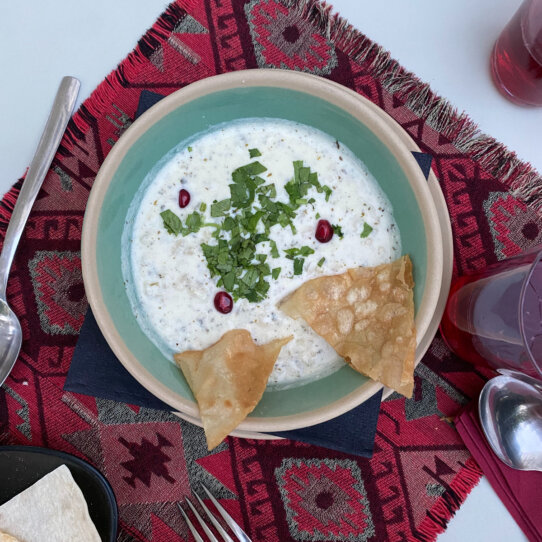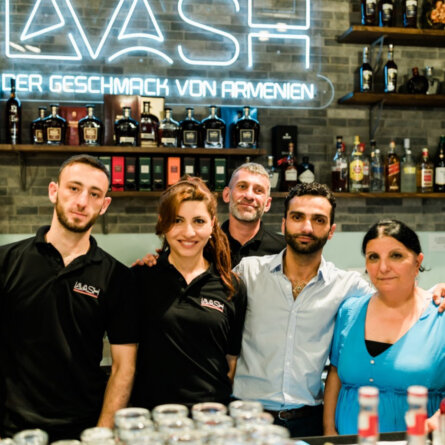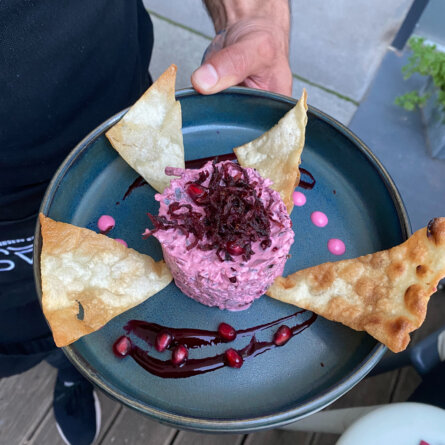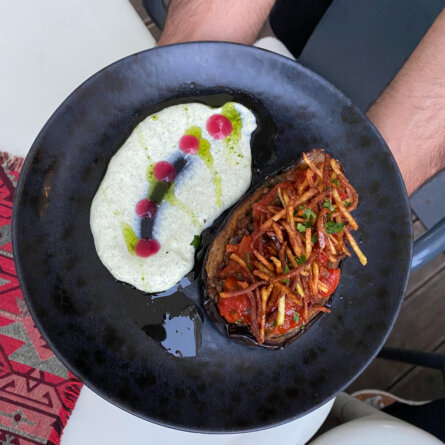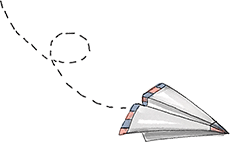Permanently closed!!!
Opening Times
Tuesday to Saturday: 11:00am - 10:00pm
At lunchtime there is a separate menu with small, quick lunch dishes
Address
Lavash
Hamerlingplatz 2
1080 Vienna-district 8
. How to get there
Contact
Pomegranate wine. The first and only thing that came to my mind when I thought of Armenian cuisine. Harutyun Hakobyan and his mother Narine opened Lavash to combat this (because many people in this country feel the same way I do). Their mission: to bring the "taste of Armenia" to the plate and familiarise the Viennese with the cuisine of the small Caucasus country.
Lavash - here comes the first lesson of the evening - is the name of the thin bread that is ubiquitous in Armenia and has been a UNESCO World Heritage Site since 2014. Also indispensable: nuts, cereals, legumes, many herbs and, yes, the pomegranate also appears in many dishes - as a raw fruit or as a syrup, the "balsamic of Armenia", as Harutyun says.
This is also the case in the beetroot tartare we get as a starter. Fresh and creamy thanks to sour cream (lesson two: sour things like yoghurt and co. play a significant role in Armenian cuisine), topped with crunchy beetroot and accompanied by crispy baked lavash wedges.
"When you eat Armenian food, you travel 2500 years back in time," says Harutyun. It is one of the oldest cuisines in the world, he says. Mama Narine gives these traditional dishes a modern makeover, serving the classic Armenian dolma (vine leaves stuffed with beef and vegetables) with yoghurt-garlic foam instead of simple sauce.
Narine Manukyan has worked as a cook in Tyrol for over 20 years, most recently as head chef in an Austrian restaurant. But for a long time, she and her son dreamed of having their own restaurant. She is proud of the traditional cuisine of her home country and especially proud that they have opened the country's first Armenian restaurant with their Lavash.
Her eyes light up when she talks about food. About their recipes, which "all come from the family, from grandmas and great-grandmas". About personal kitchen secrets and creative ideas that distinguish her dishes and make them unique. If you like, you can watch her cooking in the small open kitchen where she is busy (all alone!). "I don't trust anyone," she says with a laugh. "That's why I have to cook everything myself."
Good thing, I think to myself as I take the first spoonful of her spas. Spas is a yoghurt-based soup with hulled wheat, fresh herbs, pomegranate seeds and lavash chips - one of the most traditional Armenian dishes. It is lukewarm, which suits this summer evening wonderfully. The combination of yoghurt and wheat may sound unusual (to our palates) but makes perfect sense taste-wise. We use the soft flatbread to scrape the last bits out of the bowl.
With the soup, we drink white wine from the Karas winery: behind it is a family that returned to its Armenian homeland after many years in Argentina to make innovative wines. Wine culture in Armenia goes back many thousands of years. "Many people think of sweet wines first," Harutyun says. I was no different. But, and here comes the subsequent learning, "In the last ten years, the wine landscape has completely reinvented itself."
The result is wines like Kraki Ktor, made from the local Kangun grape variety, which tastes of bitter orange, and is fruity but not a bit sweet, rather mineral, as the vines grow in the volcanic soil around the sacred Mount Ararat.
Mount Ararat is the national symbol of Armenians - you can find it in their passports, on their coins, on their football shirts - even though it is no longer on Armenian soil but on Turkish ground. Armenia, squeezed between Georgia, Azerbaijan, Iran and Turkey, was under foreign rule for a long time. Again and again, they had to cede territories to neighbouring countries, and to this day, there are border disputes. As a result, many people have left the country.
That is why the kitchen is so important as a symbol of identity, says Harutyun. Mother and son not only want to pass on their country's culinary heritage but also want to do a little cultural mediation work. Do I know any famous people from Armenia? He asks me before the main course? I have to pass. And I learn that the singer Cher, the French chansonnier Charles Aznavour and the Kardashians all have Armenian roots. The first Viennese coffee house was also opened by an Armenian in 1685.
After this little history lesson, Harutyun brings our main courses: Butter-soft, juicy aubergines stuffed with minced meat and tomato sauce. As a vegan variant, the Garni yarakh is also available with bulgur. Just one of many plant-based dishes on the menu here.
Our second main course, Tsaghkazart, is also vegan: baked flower cabbage with roasted nuts, pomegranate seeds, fresh herbs and creamy cashew sauce. This, too, is a modern creation by chef Narine, which - like everything from her kitchen - comes beautifully presented to our table.
Our evening ends with sweet puff pastry ("handmade, of course") and thick yoghurt, matured overnight like labneh. It is accompanied by Armenian brandy (which I had never tasted before!) and finally, a glass of pomegranate wine.
